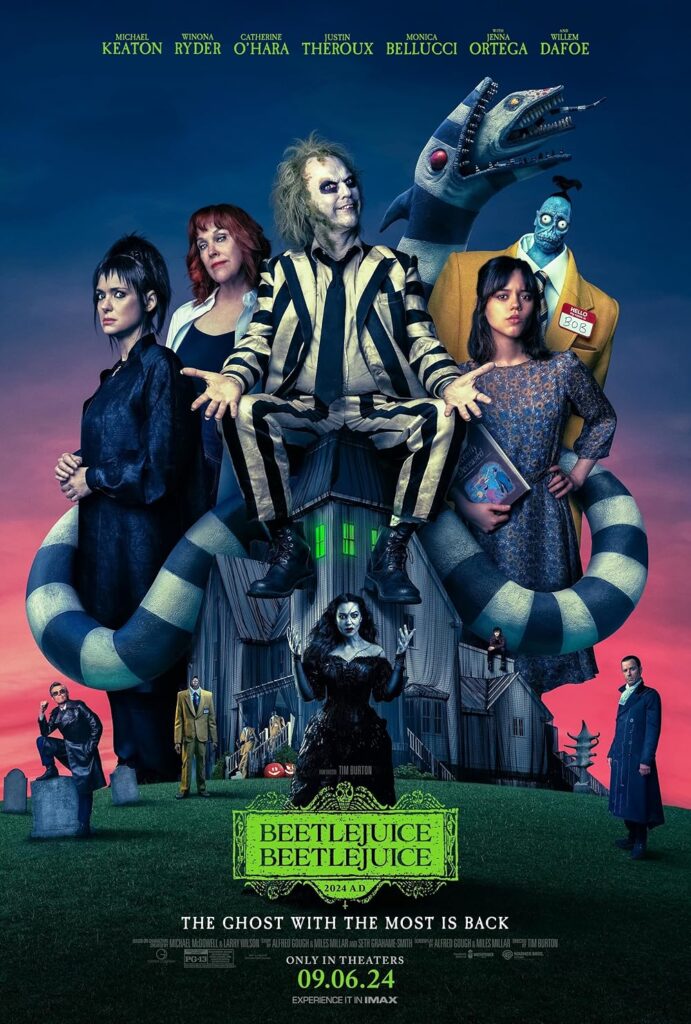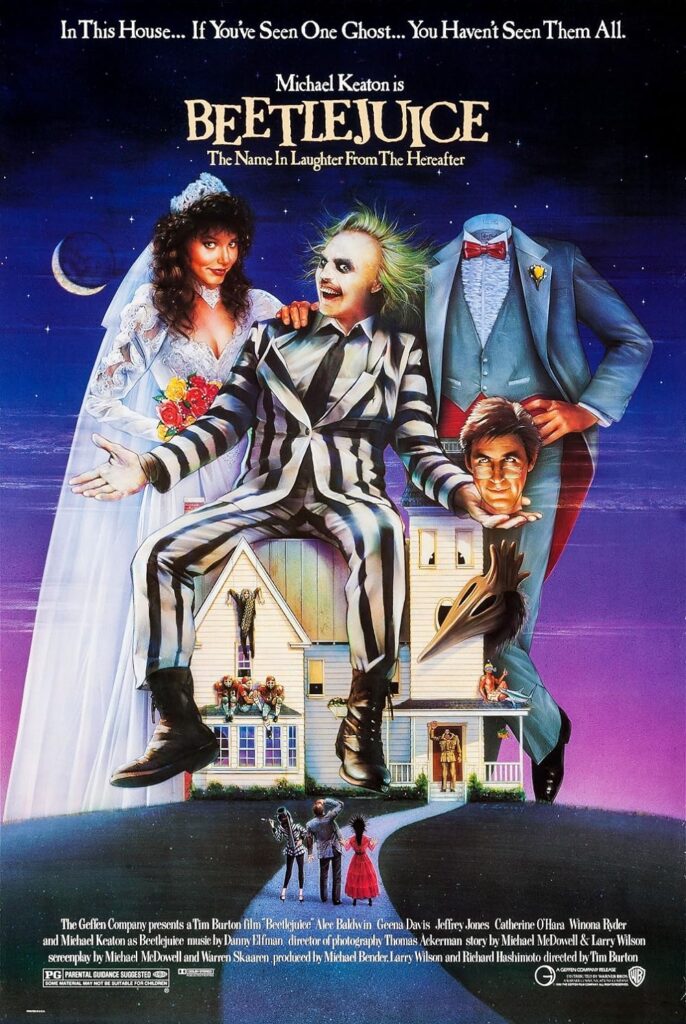
Much like last year’s quickly-forgotten Indiana Jones and the Dial of Destiny, Tim Burton’s clunky-entitled Beatlejuice Beatlejuice–the long-gestating sequel to his 1988 cult-hit Beatlejuice–took decades to produce, yet still felt like it needed to go through at least a few more revisions. Both flicks serve as Exhibits A & B for the idea that, if you can’t come up with a good sequel concept for your film immediately, then you aren’t going to come up with a better one years later, either.
At once overstuffed and undercooked, the screenwriters for Beatlejuice Beatlejuice clearly started with a few “funny” sounding set-pieces—a children’s church choir singing Harry Bellafonte’s “Banana Boat (Day-O)” at a funeral; a literal 1970s-style “Soul Train” dancing dead souls into the afterlife; a baby-Beatlejuice (obviously angling—and failing—to attain Baby Yoda status) climbing up the hospital walls; a ghoulish wedding lip-synced to the ‘60s kitsch-fest “MacArthur Park” (as though Weird Al hadn’t already done the definitive parody over 30 years ago)—and then worked backwards from there to figure out how to shoehorn them all in together. The overall effect, however, is less than the sum of its parts, nor are any of these scenes as memorable as the film needs them to be.
More egregiously, the film (in flagrant violation of the Law of Conservation of Characters) features not one but two different lying dirtbag boyfriends with nefarious designs upon the film’s two female leads: Wynona Rider as a now-middle-aged Lydia Deetz, and Jenna Ortega as her estranged daughter Astrid. It would be one thing if both Lydia and Astrid were intended to mirror each other in finding the inner-strength to defeat their deceitful love-interests as they repair their strained relationship, but that would be giving the film entirely too much credit: no, both dirtbags are as redundant as they are forgettable, and are ultimately dispatched by the titular “ghost with the most” in perfunctory fashion the moment the screenplay loses interest in them. The two ostensibly strong female leads, meanwhile, are reduced to mere damsels-in-distress, for a plot that was largely constructed as an afterthought to begin with.
There is also, incredibly, a third villain–Beatlejuice’s literally soul-sucking ex-wife out for vengeance–who is somehow even less developed, and defeated even more anticlimactically, than the other two; for that matter, an early scene wherein she crudely staples herself together could double as a metaphor for the film’s construction overall. Willem Dafoe is similarly wasted as a hammy dead-actor-turned-police-chief on the hunt for Beatlejuice and Lydia, and whose character arc matters so little to the main plot that he could have been cut entirely without anyone noticing. But then, the same could be said of the film itself.

What is irritating about this glut of villains is that the original Beatlejuice, I dare say, featured no actual villains at all! I’m serious here. Oh, it has plenty of antagonists, for sure–the yuppie Deetzs gutting out the Maitland’s charming old New England home; Otho the arrogant interior decorator performing an unauthorized exorcism that almost kills off the ghosts of the Maitlands for good; the indifferent case-workers in the afterlife shuffling off the Maitlands from one bureaucratic headache to another; the titular “bio-exorcist” himself wrecking havoc wherever he goes–but what is important to emphasize is that none of these characters are actually flat-out evil.
Delia Deetz for example is introduced as a potentially evil stepmother, yet though she is often overbearing and eccentric, she is never cruel; her husband Charles Deetz is smarmy and neurotic, but ultimately sympathetic; and crucially, though neither of them even pretend to understand their Goth daughter Lydia, they never prevent her from dressing or expressing herself how she chooses, either. They are also in the end content to co-exist with the Maitlands in their haunted house, no hard feelings.
Likewise, Otho may self-present as an arrogant jerk, but he does express sincere remorse when the exorcism gets out of hand; the case-workers in the afterlife are not so much callous as just comically overworked; and Beatlejuice himself is less a malevolent demon than a trickster-god who does indeed save the Maitlands when it counts.
I mention all this because, contrary to some of the other negative reviews of the film, I maintain that what’s missing from the long-delayed sequel isn’t the shameless vulgarity of the first film (though it is missing that as well), but on the contrary, the original’s good-natured humor! It was not Beatlejuice’s crude obscenity, but rather his childlike whimsy, that made the original so endearing! Indeed, everything about the 1988 production–the goofy stop-motion sand-worms, the campy costumes and set designs, the Harry Bellafonte dance-numbers, Danny Elfman soundtrack and tight 90 minute run-time itself–is possessed of a childhood insistence that none of this is even remotely realistic, that no one here is bothering to portray an accurate afterlife, that no one is ever in any real danger, that we’re all just playing make-believe and having a little fun. One could argue that such an approach robs the film of its stakes, yet ironically the opposite is the result: the original Beatlejuice felt all the more alive, once it was freed to treat death itself as artificial.
Overall, I can’t shake the feeling that the core problem with the sequel is that it features at least three villains, while the original featured none. This fact feels integral to me because, for all of the first film’s gleeful artificiality, its good-natured humor is in fact its most realistic touch: this idea that the next life will not feature any real villains whatsoever; that everything really will be alright in the end; that all of our concerns about the evils and the horrors of this world will feel laughably trivial before the wildness of Eternity; that even death itself (“O death, where is thy sting?”) will be revealed as one big hearty joke.
